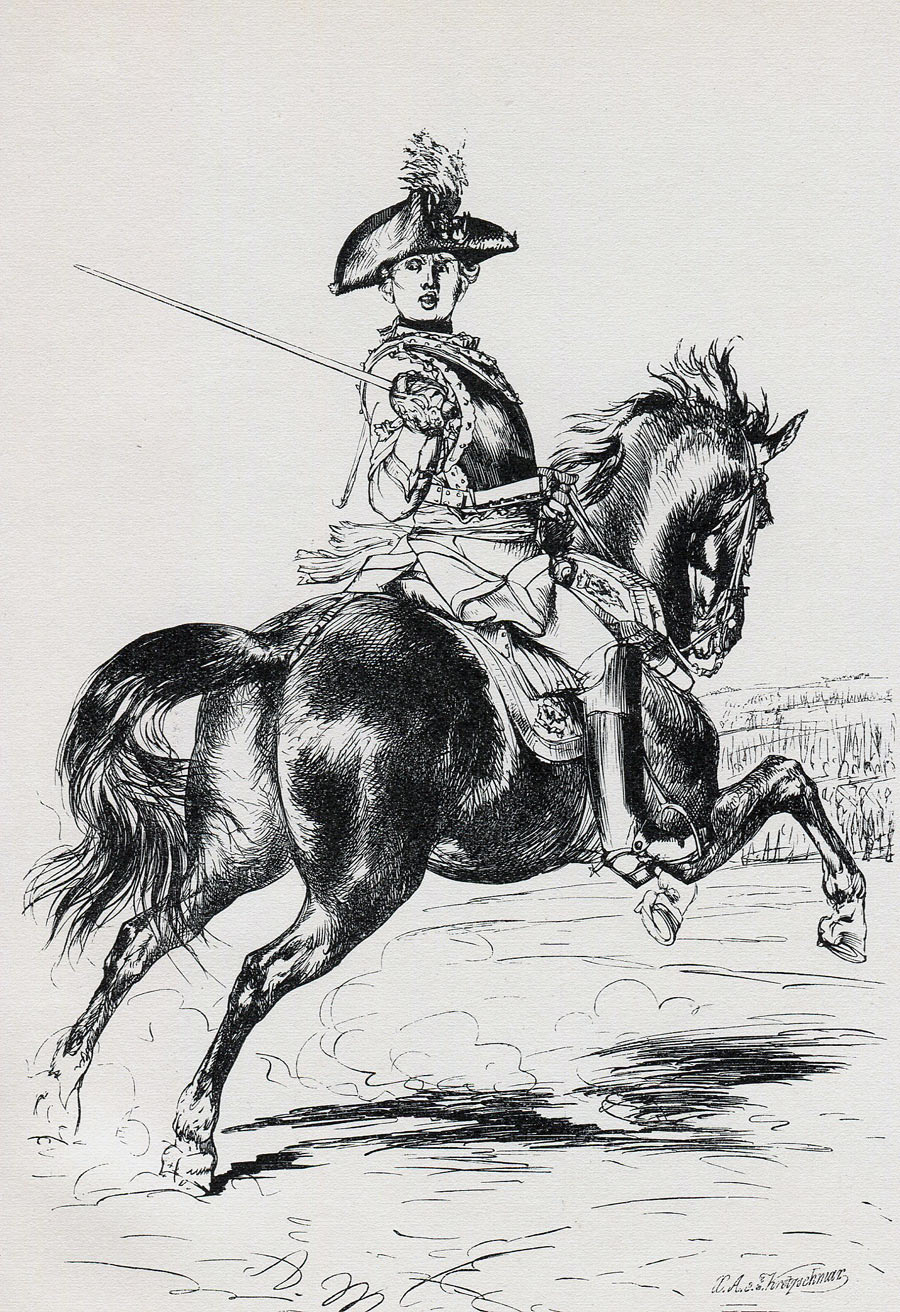Frederick the Great’s Pyrrhic victory over the Russian Army on 25th August 1758

Frederick the Great at the Battle of Zorndorf on 25th August 1758 in the Seven Years War, leading the infantry of General Dohna’s right wing to the attack: picture by Carl Rohling
The previous battle in the Seven Years War is the Battle of Leuthen
The next battle in the Seven Years War is the Battle of Hochkirch
Battle: Zorndorf
Date of the Battle of Zorndorf: 25th August 1758
Place of the Battle of Zorndorf: On the eastern bank of the River Oder to the North of Frankfurt am Oder.
War: The Seven Years War.
Contestants at the Battle of Zorndorf: Prussians against a Russian army
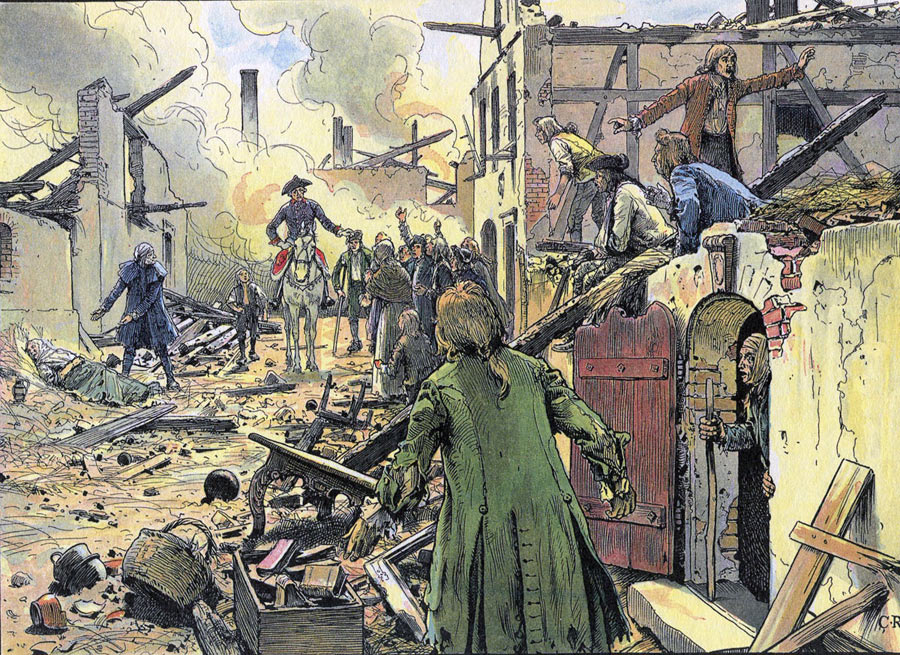
Frederick the Great inspects the damage in the town of Küstrin inflicted by the Russian Cossacks before the Battle of Zorndorf 25th August 1758 in the Seven Years War: picture by Carl Röhling
Generals at the Battle of Zorndorf: King Frederick II of Prussia, Frederick the Great, commanded the Prussian Army against General Fermor who commanded the Russian Army.
Size of the Armies at the Battle of Zorndorf: Prussians; 25,000 infantry, 10,500 cavalry, 35,500 in all and 193 guns. Russians; 36,500 infantry, 3,500 cavalry, 3,000 Cossacks, 43,000 in all and 136 guns.
Winner of the Battle of Zorndorf:
A narrow victory for the Prussians although some authorities describe the battle as a draw.
Uniforms and Equipment at the Battle of Zorndorf:
The Prussian infantry and artillery wore a dark blue coat turned back at the lapels, cuffs and skirts, with britches and black thigh length gaiters. Each soldier carried on a cross belt an ammunition pouch, bayonet and ‘hanger’ or small sword. Headgear for the line companies was the tricorne hat, with a flattened front corner, bound with white lace. Grenadiers wore the distinctive mitre cap with a brass plate at the front. Fusilier infantry regiments and artillery wore a smaller version of the grenadier cap.
The infantry carried a musket as the main weapon. This single shot firearm could be loaded and fired by a well trained soldier around 3 to 4 times a minute. As an early improvement Frederick introduced the iron ramrod and then the reversible ramrod (the soldier did not have to worry whether he had the ramrod the right way round) which increased the rate of fire of his infantry, the old wooden ramrod being liable to break in the stress of battle.

Prussian Infantry Regiment von
Kanitz No 2 (the regiment lost 20
officers and 844 men in the battle): picture by Adolph Menzel as part of his series of pictures ‘Die Armee Friedrichs des Grossen in ihrer Uniformierung’
The Prussian infantry regiment was based on the cantonment with soldiers joining their local regiment. In peacetime soldiers were released for key agricultural times, sowing and harvesting. In the autumn, reviews were conducted of all regiments to check they were up to the required standard. Each year regiments were selected to undergo review at Potsdam under the eye of the King. Officers whose soldiers’ performance was considered by Frederick to be substandard were subject to a public tongue lashing and in extreme cases dismissal on the spot.
The efficiency of the Prussian regiments at drill enabled them to move about the battlefield with a speed and manoeuvrability that no other European Army could equal. The Battle of Rossbach is a striking example of this facility.
During the peace between the sets of wars Frederick devised and practised his ‘oblique’ formation in attack. The technique was to deliver an assault on the flank of an enemy army. The Prussian infantry battalions would advance to the attack ‘in echelon’, or each battalion, after the leading battalion, setting off 50 paces after its predecessor. The Battle of Leuthen was the only battle in which Frederick was able to deliver a complete ‘oblique’ attack and did so with devastating success.
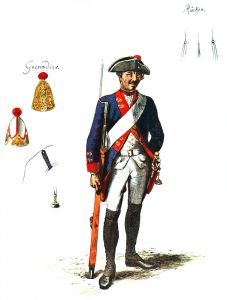
Prussian Infantry Regiment von
Lehwaldt No 14: picture by Adolph
Menzel as part of his series of
pictures ‘Die Armee Friedrichs des
Grossen in ihrer Uniformierung’
Heavy cavalry of the period comprised cuirassiers and dragoons. The Prussian cuirassiers wore a white coat, steel cuirass, white britches and thigh boots. Prussian Dragoons wore a light blue coat. The headgear was a tricorne hat. Weapons were a heavy cavalry sword and single shot flintlock carbine.
The light cavalry arm was provided by the Prussian Hussar regiments. The true hussars were Hungarians in the Austrian service. The hussars of other armies were given the same dress as the original hussars and required to perform a similar light cavalry role of reconnaissance and harassing the enemy’s outposts and supply columns.
Following the Battle of Mollwitz and in particular after the First Silesian War the Prussian Hussars were re-organised and re-trained to provide an efficient scouting and light cavalry service. Frederick found in Colonel von Zieten the ideal officer to implement the improvements in the hussar regiments. The Prussian Hussars wore the traditional hussar dress of tunic, britches, dolman (slung jacket), busby (fur hat) with bag, sabretache (leather wallet on straps hanging from the belt) and curved sword.
Unlike the original Hungarian Hussars of the time who were considered to be little more than indisciplined freebooters the Prussian Hussars were well able to take a position in the cavalry line and perform valuable service in battle, as at the Battle of Hohenfriedburg and on other occasions.
Frederick implemented significant improvements to the Prussian Army between the two Silesian wars. The eleven years of peace before the Seven Years War enabled Frederick to bring the various arms of the Prussian service to a further high pitch of efficiency. Each year the regiments were subjected to a training cycle that culminated in reviews at Potsdam under the King’s exacting eye. Autumn manoeuvres were held in Silesia, the area where much of the expected warfare would be conducted (see the benefit of these manoeuvres at the Battle of Leuthen).
The Prussian infantry was a tested and established asset and required little improvement. Most of the innovation was targeted at the cavalry, artillery and technical arms.
One unfortunate development from the Silesian Wars was that Frederick formed the view that his infantry could win their battles simply by the steadiness of their advance. The Seven Years War began with the Prussian infantry doctrine being to advance with muskets at the shoulder and not to pause to fire on the enemy. The Battle of Prague showed this doctrine to be badly misguided and it was abandoned after causing the Prussians substantial casualties.
The Prussian infantry was soon trained to advance making brief halts to fire and reload, enabling it to deliver successive volleys as it marched up to the opposing army, a technique used to devastating effect at the Battle of Rossbach.
During the course of the Seven Years War Frederick extensively re-organised the artillery. New equipment was introduced, the guns standardised and the artillery formations overhauled. Frederick introduced horse artillery that could move around the battlefield.
Frederick brought the Prussian cavalry to a level of effectiveness unrivalled by any other European Army of any period. The basic requirement was a high standard of horsemanship in every soldier. A trooper was required to ride his horse every day, an exacting obligation in peacetime. Contrast this with the practice of the British regiments of horse and dragoons of the time, in which as a measure of economy the horses had their shoes struck off and were put out to grass unridden for the whole of the summer (see Viscount Molesworth’s standing orders for his dragoon regiment).
Every year Frederick exercised the cavalry during the autumn manoeuvres. Frederick required the cuirassier and dragoon regiments to form line at the gallop and deliver a charge, with the troopers so close that they rode knee behind knee with the horses touching. Frederick developed the capability of the cavalry year by year. Finally he required his mounted regiments to be able to deliver three such charges one after the other at full gallop.
The effect of this exacting training was graphically illustrated by the performance of the Prussian cavalry force led by General von Seydlitz against the Russians at the Battle of Zorndorf on 25th August 1758.
It was Frederick’s order that any Prussian cavalry commander receiving a charge at the halt would be tried by court-martial. Commanders had the discretion to attack if they considered that a favourable opportunity existed, without waiting for orders.
The Battle of Rossbach is another good example of the quality of the Prussian heavy cavalry and its ability to deliver battle winning charges through remaining under the tight control of its commander.
Background to the Battle of Zorndorf:
On his accession as King in Prussia, Frederick II annexed the Austrian province of Silesia. Frederick spent the next 25 years fighting to maintain his hold on Silesia. He fought the two Silesian Wars against Austria (battles of Mollwitz, Chotusitz, Hohenfriedberg, Soor and Kesselsdorf) which ended with the Treaty of Breslau on Christmas day 1745. 8 years of peace intervened before the outbreak of Frederick’s most severe test, the Seven Years War, in which Prussia was arrayed against Austria, Saxony, the German Reich states, France, Russia and Sweden. Frederick began the war with a pre-emptive invasion of Bohemia in 1756; fighting against the Austrians the Battle of Lobositz and in 1757 the Battles of Prague and Kolin and against the French the Battle of Rossbach and again against the Austrians the Battle of Leuthen.
Account of the Battle of Zorndorf:
Frederick the Great spent the spring and early summer of 1758 in the abortive siege of the Moldavian town of Olmϋtz. The Austrian success in ambushing a large Prussian convoy with urgently needed supplies forced Frederick to abandon the siege and retreat through Northern Bohemia and into South Western Silesia; reaching Glatz on 4th August 1758. He there had to juggle his resources. The Austrian Marshal Daun was following the retreating Prussians, albeit at a leisurely pace. Saxony was held by just 20,000 Prussians. But the most immediate threat to the Prussian state was the Russian army of General Fermor advancing from the East towards Küstrin on the Oder. The Russians were opposed by 26,000 Prussians under General Dohna. If Küstrin fell the Russians had only a 50 mile march to reach Frederick’s capital city, Berlin.
Frederick resolved to march at speed to attack Fermor, with the aim of being back in southern Silesia to confront Daun within 3 weeks.
Frederick marched on 11th August 1758 with 11,000 men to join Dohna and his Prussian army. Together they would confront General Fermor with his 56,000 Russians.
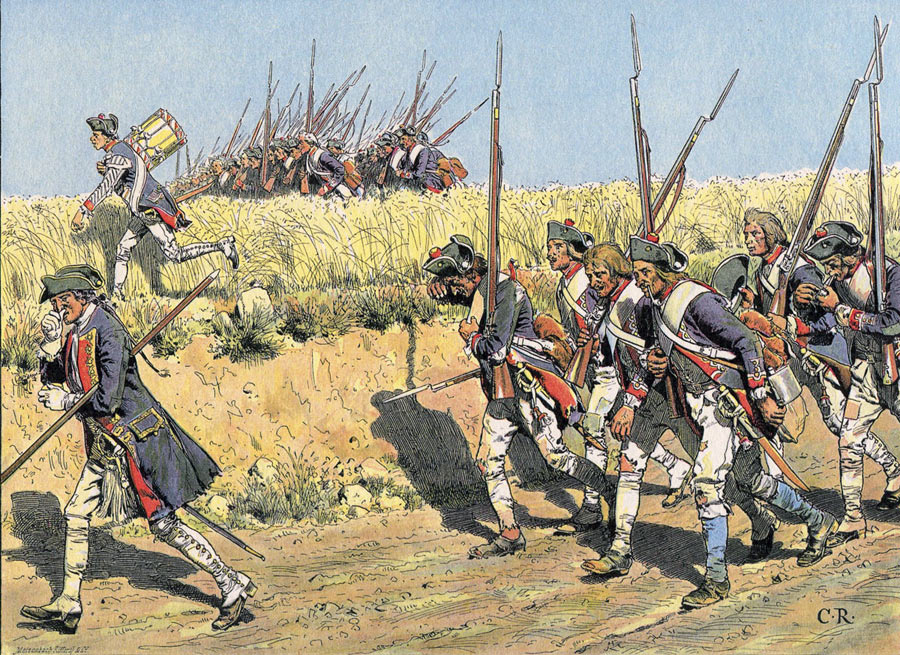
Prussian infantry advancing to meet the Russian Army before the Battle of Zorndorf 25th August 1758 in the Seven Years War: picture by Carl Röhling
The Russians reached the Oder River on 15th August 1758 and began a bombardment of the town of Küstrin on the banks of the Oder. Cossacks and Russian troops pillaged the surrounding towns and villages.
Frederick force marched down the Oder to Frankfurt, arriving with his corps on 20th August 1758. Lodging in the town the Prussians could clearly hear the bombardment of Küstrin. Frederick had been imprisoned in the castle at Küstrin in his youth while out of favour with his father King Frederick William.
Early on the next morning Frederick rode with his staff to meet General Dohna outside Küstrin. Dohna’s troops were in good order but Frederick was far from pleased with the army’s feeble attempts at resisting the Russian advance.
On hearing of Frederick’s arrival Fermor drew his army off from Küstrin and took up positions on the eastern side of the Oder. Frederick and his troops entered the town and found it devastated by the Russian bombardment. The sight filled them with determination to inflict revenge on the Russians.
General Fermor sent a force of 11,000 men down the Oder to the next major bridge to prevent Frederick from crossing the river and attacking him. In doing so Fermor completely underestimated the technical ability and determination of the Prussian army and reduced his immediate force to 45,000 troops.

Prussian Feld Jӓger: picture by Adolph Menzel as part of his series of pictures ‘Die Armee Friedrichs des Grossen in ihrer niformierung’
Prussian guns opened fire on the Russian positions on the far side of the river while Frederick made plans to cross the Oder further north. General Kanitz established a bridge of boats 20 miles downstream from Küstrin while Prussian infantry crossed the river by boat. This crossing point interposed the Prussian army between Fermor and his detached force, which was of no further use to the Russian commnander. Once across, the Prussian army marched back up the river on the east bank. The weather was extremely hot and the speed of the march caused significant casualties among the hurrying infantry.
In the afternoon of 24th August 1758 the Prussian army came up to the Mietzel stream, a tributary of the Oder. The Russian army could be glimpsed on the far side of the Mietzel but some way back, the dense forest making it difficult to see their positions in detail. Frederick halted and pushed the Prussian advance guard over the Mietzel at Neu Dammer Mϋhle, opposite the far right of the Russian position. Bridges were then built at this point. With the crossing at Neu Dammer Mϋhle secured, the Prussian army was well placed to launch its attack the next day.
Frederick spent the night in the Neu Dammer Mϋhle. 2 forestry officials who could be expected to know their way around the area were drafted in to guide the Prussian advance; one to accompany Frederick and the Prussian infantry columns through the forest of Zicherer-Heide around the Russian right flank, the other to guide the Prussian cavalry in a wider advance to the East of the infantry.
Emerging from the mill in the early morning Frederick greeted his generals with the pronouncement “Congratulations. We have already won the battle.” In spite of the warnings of his trusted Scottish lieutenant, Field Marshal Keith, who had served in the Tsar’s army and urged his king that the Russian soldiers were not to be underestimated, Frederick viewed his opponents with contempt.
The Prussian columns crossed the Mietzel stream in the early dawn, moved through the woods on the far side of the river and emerged near Batzlow; beyond the Russian right flank. As Frederick’s columns marched across the cultivated landscape scouting hussars drew the king’s attention to the main Russian baggage train drawn up in a ‘Wagenburg’ to the south of Gross Camin, a kilometre to their left. The proposal was put to the king that capture of the baggage train would hamstring the Russian army and force its retreat through lack of supplies, making a battle unnecessary. But Frederick and his army were enraged by the devastation inflicted on the area by the Russians. Their fighting blood was up and most significantly Frederick thought he had an easy victory in his grasp.
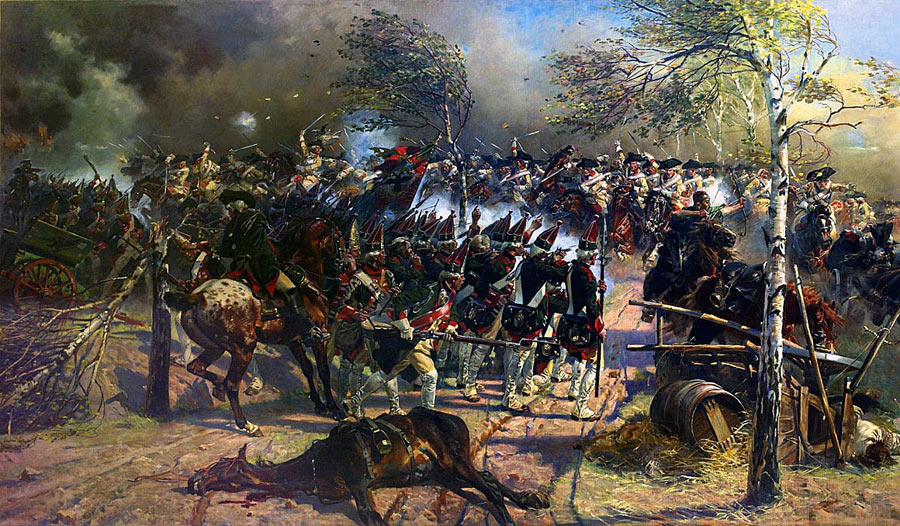
Charge of the Prussian Cuirassiers led by Seydlitz at the Battle of Zorndorf 25th August 1758 in the Seven Years War: picture by Carl Röhling
The Prussian army wheeled to the West and marched to the line of Zorndorf-Wilkersdorf, before swinging to the North and beginning its assault on the Russian rear; or what would have been their rear if Fermor had not turned his army about to meet the attack. The Prussian assault began with its leading regiments on the new right of the Russian line between the streams of the Zabern-Grund and the Galgin-Grund.
The Prussian advance guard under Lieutenant General Manstein began the assault on the far left, along the line of the Zabern-Grund. Manstein was followed by the left wing of the main Prussian army under Lieutenant General Kanitz moving up to his right rear. Lieutenant General von Bieberstein came up in support of Kanitz with his cavalry. Lieutenant General Seydlitz with his cavalry force moved up on the far side of the Zabern-Grund keeping level with the advancing Prussian infantry. While this attack went in Colonel Moller’s artillery fired a supporting barrage from positions around the burning village of Zorndorf that had been pillaged by the Cossacks. General Dohna commanded the ‘refused’ Prussian right wing which remained stationery as the left wing pressed its attack.
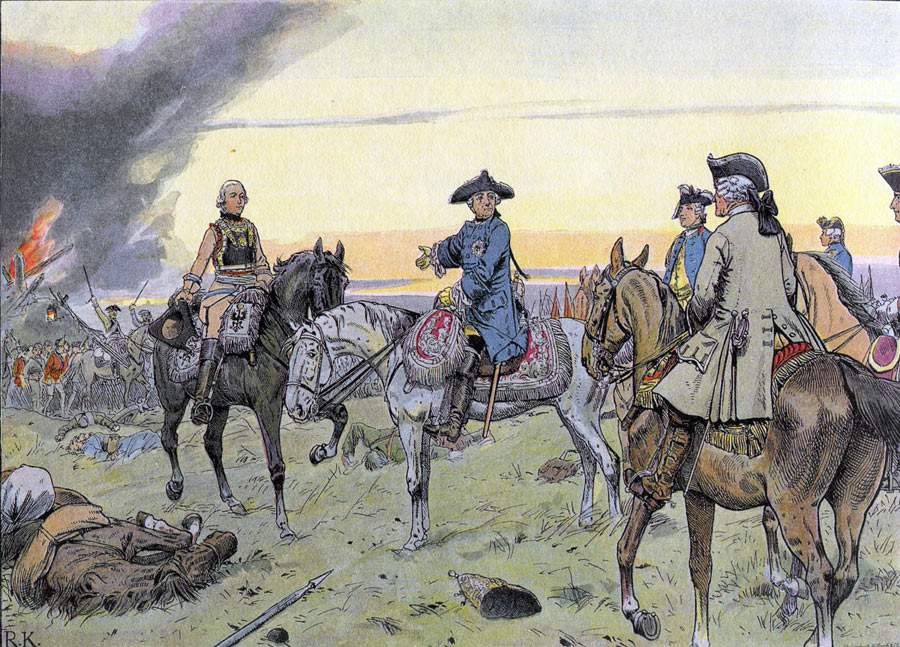
Frederick the Great compliments General von Seydlitz on his conduct during the Battle of Zorndorf 25th August 1758 in the Seven Years War: picture by Carl Röhling
Moller moved his guns forward to fire the barrage from a shorter range. The noise of the battle was reported as stupefying, with Russian powder wagons exploding in the burning vegetation. In a lull in the racket Frederick commented on the music being played by the band of one of his advancing regiments and was told it was the hymn “Ich bin ja, Heer, in deiner Macht”-“Now Lord I am in thy keeping.” Frederick hummed the melody as the regiment marched off into the dense smoke caused by the heavy firing.
The smoke proved a major difficulty for Manteuffel’s advancing infantry. The Russian line could not be seen until the Prussians were within 40 yards. The blasts of musketry and canister from the waiting Russian foot and guns inflicted high casualties on Manteuffel’s battalions. Under pressure and unsure of its position the Prussian advance guard drifted away from the Zabern-Grund, leaving its flank exposed to a charge by a force of Russian cavalry. In this devastating attack, some units suffering 60% casualties, the Prussian advance guard was driven back in confusion.

Prussian Husaren-Regiment von
Malachowski No 7: picture by
Adolph Menzel as part of his
series of pictures ‘Die Armee Friedrichs des Grossen in ihrer Uniformierung’
Kanitz was required to bring his regiments up in support of the advance guard, but failed to comply with the route taken by Manteuffel, heading straight to his front. Passing through the Stein-Busch several of Kanitz’s regiments became disordered. Emerging into the open Kanitz’s division met the heavy fire of the Russian centre and was attacked on its open left flank. Frederick and Prince Moritz brought up Bieberstein’s cavalry to lessen the pressure on Kanitz’s faltering advance.
It was at this point that Seydlitz launched his decisive attack on the extreme left wing. Seydlitz had been given the role of covering the Prussian left flank from the far side of the Zabern-Grund with his 36 squadrons of cuirassiers and hussars. As the Prussian infantry assault became more enmired Frederick sent message after message to Seydlitz ordering him to attack. Seydlitz refused to act on these messages saying in answer to one “Tell the king that after the battle my head is at his disposal, but until then he will have to allow me to use it as I see fit.”
Finally Seydlitz considered that the moment had come to launch his assault. His cavalry crossed the steep sided Zabern-Grund, formed line at the gallop and launched a charge that swept away swathes of Russian infantry. The Russian right flank collapsed under the weight of Seydlitz’s attack.
On the Prussian right Dohna’s infantry moved forward to relieve the pressure on Kanitz but were counter-attacked by General Demiku’s cavalry from the Russian left wing.
At around this time Frederick seems to have been struck with indecision by the way his plans were collapsing around him, but revived sufficiently to bring up cavalry regiments to relieve the hard pressed infantry.
Order began to break down in both armies; Prussian hussars looting the Russian baggage and the Russian soldiers breaking open stores of alcohol.
At around 9pm the fighting ended. Dohna’s advance had pushed the Russians out of their positions so that the Prussians ended the day in the area of Quartschen to the rear of the original Russian position; while the Russians had been pushed towards the smouldering remains of the village of Zorndorf.
Aftermath to the Battle of Zorndorf:
Both armies remained on the field of battle until 1st September 1758 when Fermor finally withdrew enabling Frederick to return to Saxony and face the renewed Austrian advance.
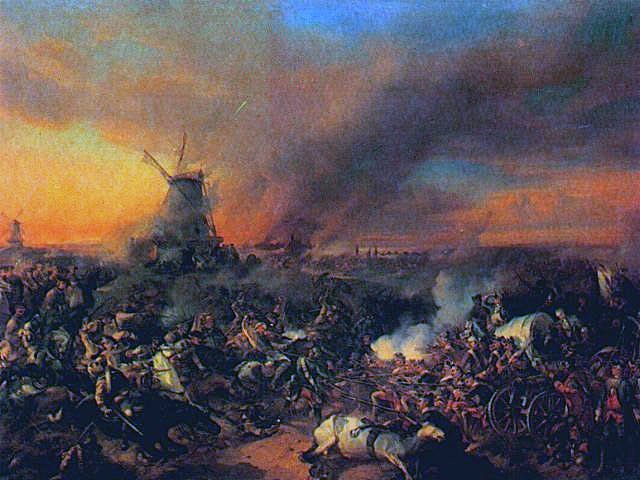
Smoke and slaughter in the Battle of Zorndorf 25th August 1758 in the Seven Years War: picture by an unknown artist
Casualties at the Battle of Zorndorf:
Russian casualties were 18,000 and the Prussian casualties 12,800, one third of Frederick’s army.
Anecdotes from the Battle of Zorndorf:
- Zorndorf has been described as the most terrible of the battles of the Seven Years War. Keith’s warning to Frederick on the fighting qualities of the Russian soldiers was fully born out.
- Frederick considered the hero of the battle to be Seydlitz for his devastating attack from the left wing. Seydlitz’s charge is held up by Colonel Maude in his authoritative book ‘Cavalry, its past and future’ to be the near perfect example of cavalry in battle. Colonel Maude states: “Seydlitz, with thirty three squadrons, fifteen of which were cuirassiers, the remainder hussars, had been moving round the Russian right on the further side of the boggy valley of the “Zaber”, on which their flank rested, and had caused adjutants and pioneers from each regiment to reconnoitre and improve passages across it broad enough for half-troop front. Seeing what was happening on the other side of the stream, he now ordered each regiment to advance in column of half-troops from its right and cross the stream by the above-mentioned passages, two regiments (ten squadrons) of cuirassiers to attack the pursuing infantry, and the remaining regiment, his own, to charge the enemy’s cavalry, the hussars to follow as a second line. These orders were obeyed. As each regiment crossed the bottom, it formed line to the front at the gallop, and went straight for its target. The shock of the first line was not everywhere successful, but the prompt support of the following hussars completed the work; and after a few minutes of hand-to-hand combat, the Russian cavalry was driven from the field and their advanced infantry practically destroyed….”
- Frederick singled out the regiments of Dohna’s right wing for praise, particularly Prinz von Preussen, 18, and Forcade, 23.
- Frederick was devastated by the ferocity of the battle and the scale of the casualties. Frederick’s adjutant Captain von Oppen was found dead after the battle with some 40 wounds.
- Pastor Täge who was at the Battle of Zorndorf in the Russian ranks was particularly struck by the advancing Prussian bands playing the Lutheran hymn “Ich bin ja, Heer, in deiner Macht”-“Now Lord I am in thy keeping.” In later life, whenever he heard the hymn tune, it took him back to the Battle of Zorndorf, the noise, the smoke and the casualties.
- Zorndorf exactly illustrates the components of Frederick’s military character: his gross over confidence, his inability to listen to advice, even from those he claimed to trust, his impetuosity and aggression, his failure to ensure that he had sufficient information on the lay of the land and the nature of his enemy’s position before launching his attack, his assumption that his subordinates understood what they had to do without giving them full instruction, his dependence on key subordinates and his collapse of will at moments of extreme crisis.
References for the Battle of Zorndorf:
Frederick the Great by Thomas Carlile
Frederick the Great by Christopher Duffy
The Army of Frederick the Great by Christopher Duffy
The Army of Maria Theresa by Christopher Duffy
Russia’s Military Way to the West by Christopher Duffy
The previous battle in the Seven Years War is the Battle of Leuthen
The next battle in the Seven Years War is the Battle of Hochkirch

